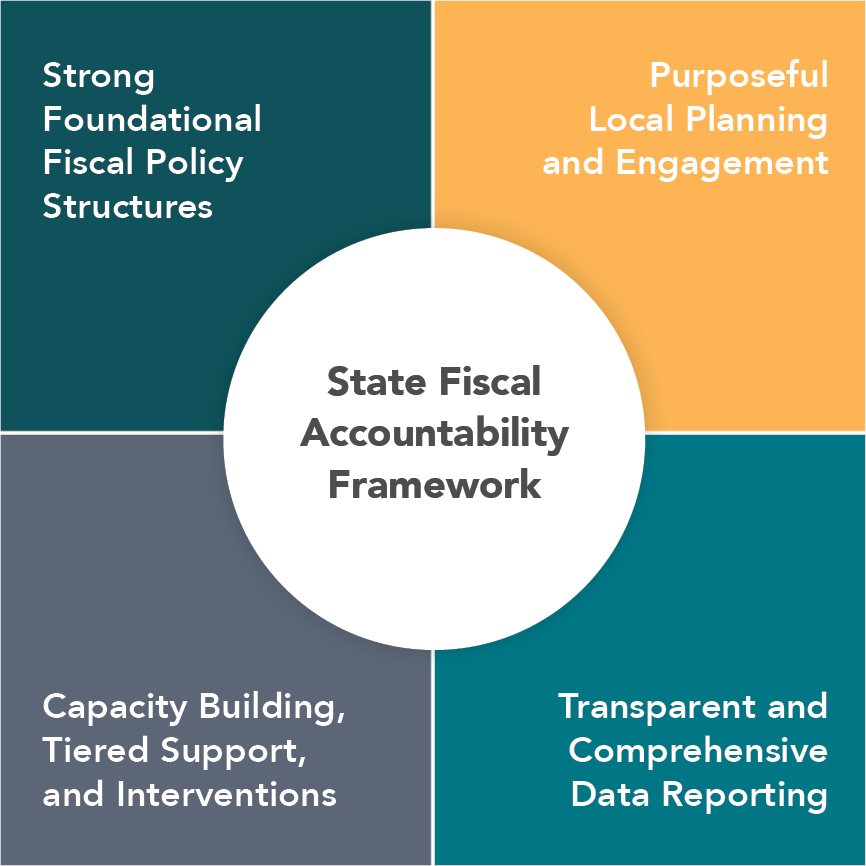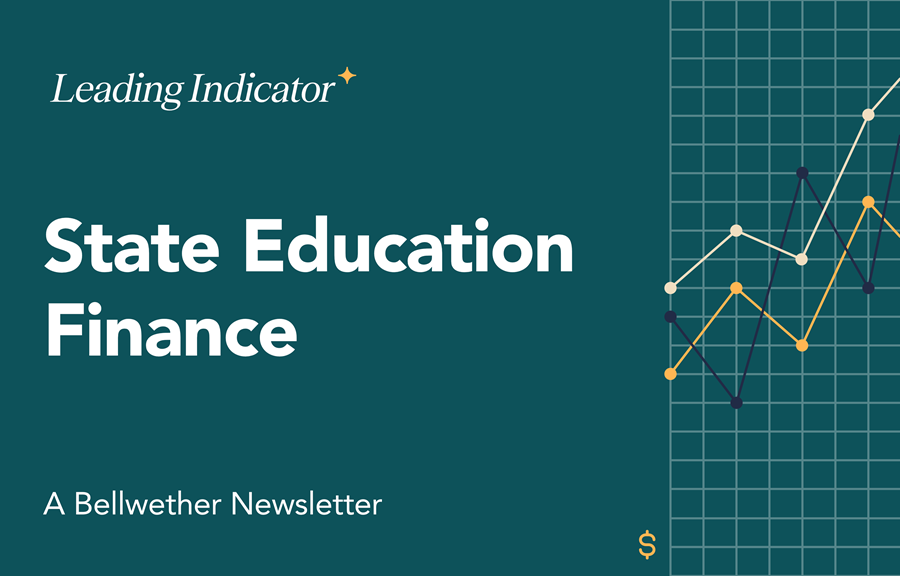As the 2025 State Legislative Season Winds Down, What’s Next?
As June unfolds, most state legislative sessions and budget processes are fully adjourned or approaching their final deadlines. The state-level funding picture for the 2025-26 school year is becoming clearer, even as federal leaders continue to negotiate over their budget (this includes the “One Big Beautiful Bill” of tax and spending measures, and a detailed version of the Fiscal Year (FY) 2026 proposed budget for the Department of Education — both discussed below).
But what happens after state leaders allocate funding to K-12 districts and schools? In our work with state leaders and advocates on school funding reform, we often hear questions like “How will I know if this money is working for students?” or “How do I make sure this money is well spent?” Systems of fiscal accountability are the answer but designing them well is a challenging task.
 Our team’s latest report goes deep on this topic and offers a framework for state leaders and advocates. First, it doesn’t make sense to go hard on fiscal accountability before creating a school funding system that’s aligned with state goals, and both sufficient and equitable enough to enable school success. Second, states should balance guardrails, transparency, and intervention mechanisms with local flexibility and control. Poorly designed attempts at fiscal accountability can do more harm than good — especially since state policymakers can’t have the same level of insight into the community, school, and student contexts that should shape spending decisions as local school system leaders.
Our team’s latest report goes deep on this topic and offers a framework for state leaders and advocates. First, it doesn’t make sense to go hard on fiscal accountability before creating a school funding system that’s aligned with state goals, and both sufficient and equitable enough to enable school success. Second, states should balance guardrails, transparency, and intervention mechanisms with local flexibility and control. Poorly designed attempts at fiscal accountability can do more harm than good — especially since state policymakers can’t have the same level of insight into the community, school, and student contexts that should shape spending decisions as local school system leaders.
That said, there’s potential for fiscal accountability systems to complement academic accountability systems and create more productive connections among state investments, school actions, and student outcomes.
Take Alabama’s new RAISE Act, for example, which creates student-based funding weights for K-12 students in poverty, special education students, English learner students, gifted students, and charter school students, and allocates an additional $150 million-plus per year into those weights. To support success over the long term, the bill creates several new fiscal accountability structures:
- Capacity Building: Alabama must invest in training local leaders around strategic resource allocation; new funding under the Act is more flexible than the state’s current system.
- Planning: Starting in FY2027, districts must submit an accountability plan to the state, explaining how they’ll use funds to support and evaluate success among these student groups.
- Reporting: Alabama will include data on these student groups’ outcomes and districts’ spending on its state school report cards.
- Oversight: The state will create two new oversight bodies — one to assess the funding system, and one to monitor and potentially intervene in schools not meeting expectations. That process won’t begin until there are multiple years of investment in and experience with this new system.
The relationship between school funding and student success isn’t a perfectly straight line, but we know school resources shape student success. It takes much more than revenue alone, but without sufficient resources to address student and community needs, students and educators have a much steeper hill to climb. Hopefully, with stronger systems of fiscal accountability, state leaders can make bold investments in students and communities, with the tools in place to support effective implementation.
—Jennifer O’Neal Schiess and Bonnie O’Keefe
The Big Picture: Trends We’re Watching
K-12 education is often the largest item in states’ budgets, but it’s also in competition with other state priorities (e.g., health care, higher education, early childhood education, public safety, and housing). One big bucket of state spending is Medicaid.
In FY22, states spent more than $250 billion, or 12.9 cents of each state revenue dollar, on Medicaid, supplementing federal spending. In addition to providing health care for low-income families, especially children, Medicaid also funds many health services in schools. The “One Big Beautiful Bill” passed by the U.S. House of Representatives and currently under consideration by the Senate includes cuts and eligibility restrictions for Medicaid and food aid (the Supplemental Nutrition Assistance Program or “SNAP”).
These measures could affect K-12 schools on several levels: students would come to school with greater unmet needs, students would have less access to free meals and health services in schools, and if states need to backfill federal cuts quickly with state dollars, it could put a real squeeze on available funding for public schools
To learn more about why Medicaid matters for schools, check out a conversation between Sarah Broome, a Medicaid expert and Bellwether senior adviser, and Andy Rotherham, Bellwether co-founder and senior partner.
We’re also watching FY26 federal budget proposals for the Department of Education. The detailed Trump Administration proposal builds upon the “skinny budget” discussed in our last issue. Its $12 billion in proposed cuts include, but are not limited to:
- The elimination of some large K-12 and higher education access programs, including funding for English learners, migrant students, and adult education
- Consolidations or cuts to funding for teacher professional development, rural students, literacy, academic enrichment, homeless students, educational research, state assessments, and more, turning these programs into substantially smaller, more flexible block grants
See a summary from EducationWeek here.
State Spotlights: Notable News From Statehouses
- Colorado made further changes to its school funding system after making significant updates last year that focused on funding for at-risk students, English learner students, and rural schools. This year’s school funding bill raises the K-12 per-pupil base and directs an additional $500 million to schools over seven years. But, it shifts back the transition timeline between the old formula and the new one. This includes delaying new at-risk funding measures, and changing the way the state counts student enrollment, which is currently averaged over 3 years. A parallel bill included fiscal accountability metric reporting.
- New York updated its decades-old student poverty metric, provided $340 million for universal free school meals, and slightly increased funding for English learner students in this year’s budget. However, it did not address the more extensive funding formula challenges and recommendations in a recent state-commissioned study, including the recommendation for a concentrated poverty weight to complement the updated poverty metric.
- Texas passed a bill authorizing $8.5 billion in funding for public schools, including increases to the per-pupil base and student and district weights, and specific increases for teacher and staff salaries, educator preparation, special education, early learning, student safety, charter schools, and several other measures. This comes directly on the heels of another bill creating an education savings account program with universal eligibility, which will cost the state up to $1 billion in the first two years of implementation. Texas House Speaker Dustin Burrows described the parallel paths of these public- and private-education funding bills as the “Texas Two-Step.”
Follow the Money: What We’re Reading
- A “How Money Matters” fact sheet from the Learning Policy Institute highlights research on how school funding changes help or hurt student outcomes.
- “5 Ways to Create Fair School Funding Formulas” from Qubilah Huddleston at EdTrust showcases its organizational perspective on what adequacy, equity, fairness, and transparency should look like in state school funding formulas.
- “Changes to SNAP Could Reduce Student Access to Free School Meals” from Emily Gutierrez at the Urban Institute forecasts school impacts of cuts to federal food aid programs.
